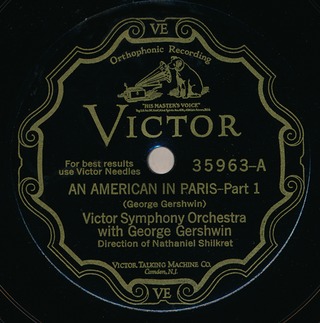
An American in Paris is a jazz-influenced symphonic poem for orchestra by American composer George Gershwin first performed in 1928. It was inspired by the time that Gershwin had spent in Paris and evokes the sights and energy of the French capital during the Années folles.

An impact crater is a depression in the surface of a solid astronomical body formed by the hypervelocity impact of a smaller object. In contrast to volcanic craters, which result from explosion or internal collapse, impact craters typically have raised rims and floors that are lower in elevation than the surrounding terrain. Impact craters are typically circular, though they can be elliptical in shape or even irregular due to events such as landslides. Impact craters range in size from microscopic craters seen on lunar rocks returned by the Apollo Program to simple bowl-shaped depressions and vast, complex, multi-ringed impact basins. Meteor Crater is a well-known example of a small impact crater on Earth.
Impressionism in music was a movement among various composers in Western classical music whose music focuses on mood and atmosphere, "conveying the moods and emotions aroused by the subject rather than a detailed tone‐picture". "Impressionism" is a philosophical and aesthetic term borrowed from late 19th-century French painting after Monet's Impression, Sunrise. Composers were labeled Impressionists by analogy to the Impressionist painters who use starkly contrasting colors, effect of light on an object, blurry foreground and background, flattening perspective, etc. to make the observer focus their attention on the overall impression.
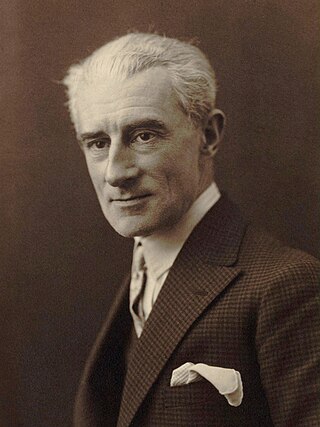
Joseph Maurice Ravel was a French composer, pianist and conductor. He is often associated with Impressionism along with his elder contemporary Claude Debussy, although both composers rejected the term. In the 1920s and 1930s Ravel was internationally regarded as France's greatest living composer.

The Chicxulub crater is an impact crater buried underneath the Yucatán Peninsula in Mexico. Its center is offshore, but the crater is named after the onshore community of Chicxulub Pueblo. It was formed slightly over 66 million years ago when an asteroid, about ten kilometers in diameter, struck Earth. The crater is estimated to be 200 kilometers in diameter and 1 kilometer in depth. It is believed to be the second largest impact structure on Earth, and the only one whose peak ring is intact and directly accessible for scientific research.

Boléro is a 1928 work for large orchestra by French composer Maurice Ravel. It is one of Ravel's most famous compositions. It was also one of his last completed works before illness diminished his ability to write music.
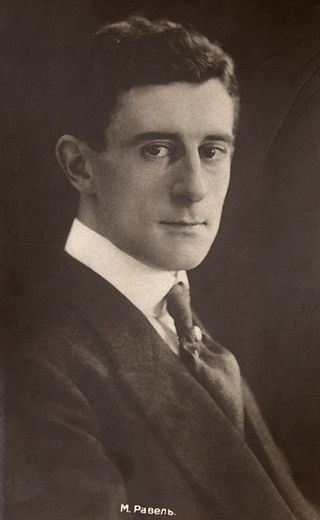
Gaspard de la nuit, M. 55 is a suite of piano pieces by Maurice Ravel, written in 1908. It has three movements, each based on a poem or fantaisie from the collection Gaspard de la Nuit – Fantaisies à la manière de Rembrandt et de Callot completed in 1836 by Aloysius Bertrand. The work was premiered in Paris, on January 9, 1909, by Ricardo Viñes. Ravel dedicated the piece to pianist Harold Bauer.

Le Tombeau de Couperin is a suite for solo piano by Maurice Ravel, composed between 1914 and 1917. The piece is in six movements, based on those of a traditional Baroque suite. Each movement is dedicated to the memory of a friend of the composer who had died fighting in World War I. Ravel also produced an orchestral version of the work in 1919, although this omitted two of the original movements.

The far side of the Moon is the lunar hemisphere that always faces away from Earth, opposite to the near side, because of synchronous rotation in the Moon's orbit. Compared to the near side, the far side's terrain is rugged, with a multitude of impact craters and relatively few flat and dark lunar maria ("seas"), giving it an appearance closer to other barren places in the Solar System such as Mercury and Callisto. It has one of the largest craters in the Solar System, the South Pole–Aitken basin. The hemisphere has sometimes been called the "Dark side of the Moon", where "dark" means "unknown" instead of "lacking sunlight" – each location on the Moon experiences two weeks of sunlight while the opposite location experiences night.
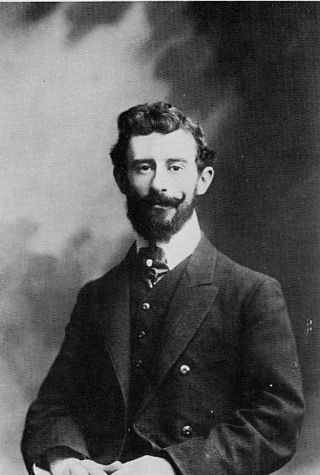
Jeux d'eau is a piece for solo piano by Maurice Ravel, composed in 1901 and given its first public performance the following year. The title is variously translated as "Fountains", "Playing Water" or literally "Water Games". At the time of writing Jeux d'eau, Ravel was a student of Gabriel Fauré, to whom the piece is dedicated. The work is in a single movement, typically lasting between four and half and six minutes in performance.

Pavane pour une infante défunte is a work for solo piano by Maurice Ravel, written in 1899 while the French composer was studying at the Conservatoire de Paris under Gabriel Fauré. Ravel published an orchestral version in 1910 using two flutes, an oboe, two clarinets, two bassoons, two horns, harp, and strings.

L'enfant et les sortilèges: Fantaisie lyrique en deux parties is an opera in one act, with music by Maurice Ravel to a libretto by Colette. It is Ravel's second opera, his first being L'heure espagnole. Written from 1917 to 1925, L'enfant et les sortilèges was first performed in Monte Carlo in 1925 conducted by Victor de Sabata.

L'heure espagnole is a French one-act opera from 1911, described as a comédie musicale, with music by Maurice Ravel to a French libretto by Franc-Nohain, based on Franc-Nohain's 1904 play ('comédie-bouffe') of the same name The opera, set in Spain in the 18th century, is about a clockmaker whose unfaithful wife attempts to make love to several different men while he is away, leading to them hiding in, and eventually getting stuck in, her husband's clocks. The title can be translated literally as "The Spanish Hour", but the word "heure" also means "time" – "Spanish Time", with the connotation "How They Keep Time in Spain".

La valse, poème chorégraphique pour orchestre, is a work written by Maurice Ravel between February 1919 and 1920; it was first performed on 12 December 1920 in Paris. It was conceived as a ballet but is now more often heard as a concert work.

George Henry Raveling is an American former college basketball player and coach. He played at Villanova University, and was the head coach at Washington State University (1972–1983), the University of Iowa (1983–1986), and the University of Southern California (1986–1994).
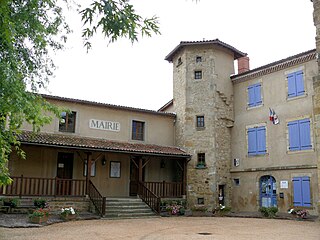
Ravel is a commune in the Puy-de-Dôme department in Auvergne in central France.

Ravel Ryan Morrison is a professional footballer who plays as a midfielder for UAE Second Division League club Precision and the Jamaica national team.
Introduction and Allegro for Harp, Flute, Clarinet and String Quartet is a chamber work by Maurice Ravel. It is a short piece, typically lasting between ten and eleven minutes in performance. It was commissioned in 1905 by the Érard harp manufacturers to showcase their instruments, and has been described as a miniature harp concerto. The premiere was in Paris on 22 February 1907.
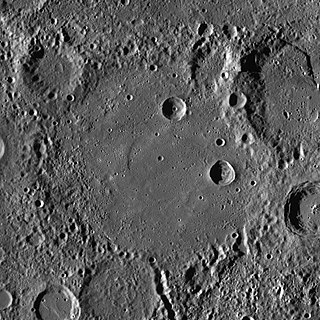
Imhotep is a crater on Mercury. It has a diameter of 159 kilometers. Its name was adopted by the International Astronomical Union in 1976. Imhotep is named for the Ancient Egyptian architect Imhotep, who lived from 2686 to 2613 BCE.

Freddie Ravel is an American keyboardist, keynote speaker, author, composer and recording artist.


















